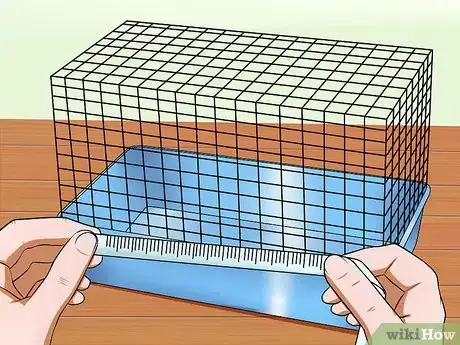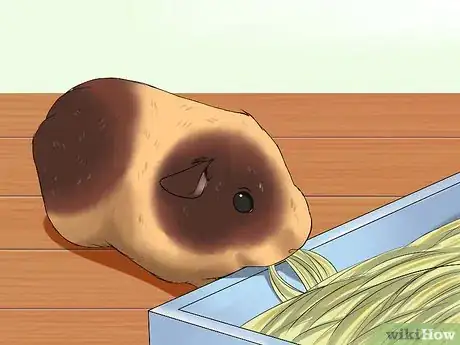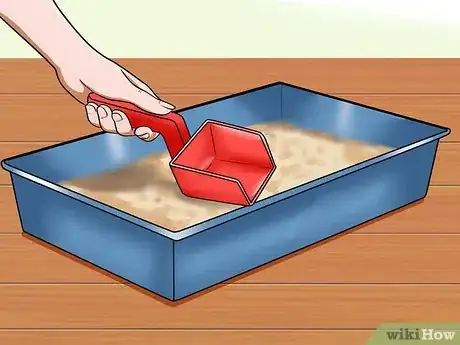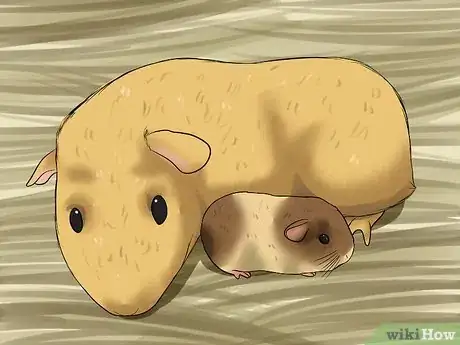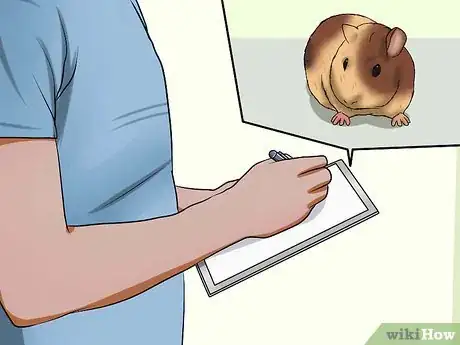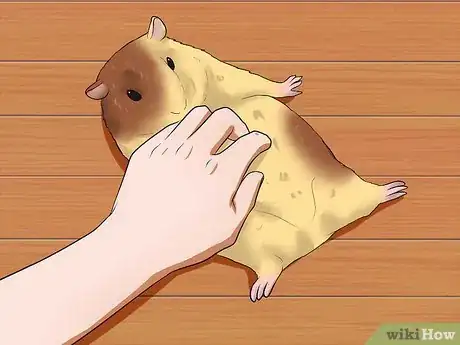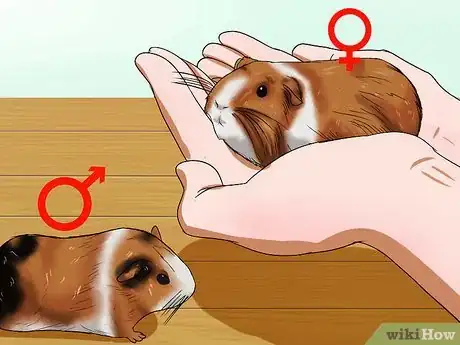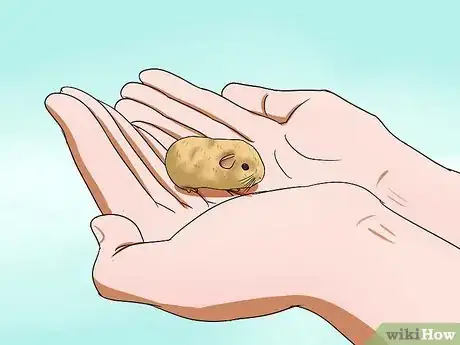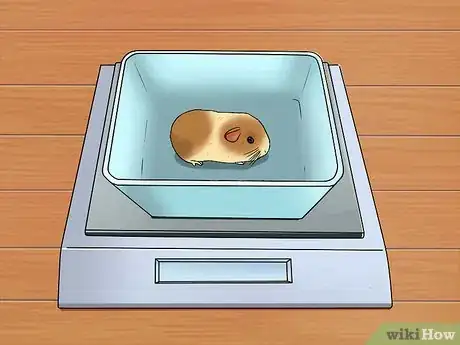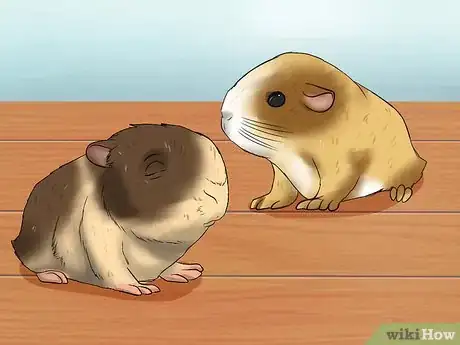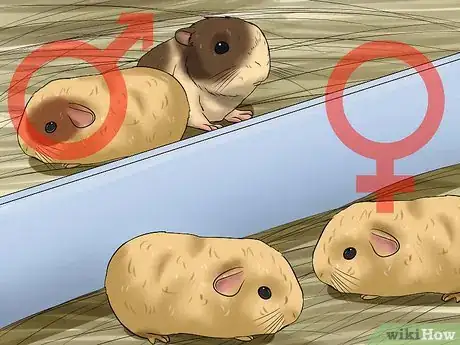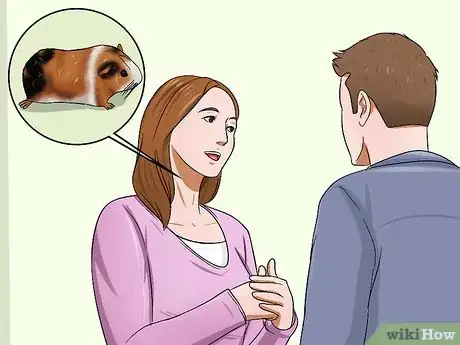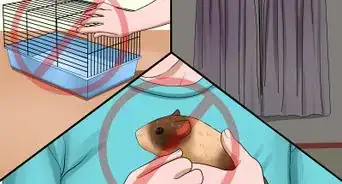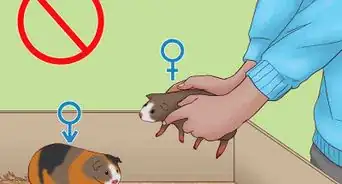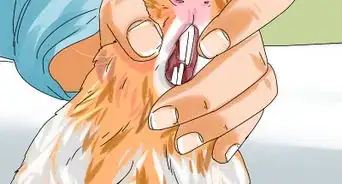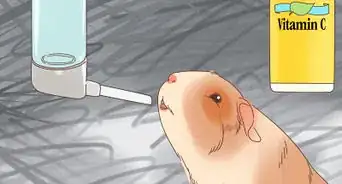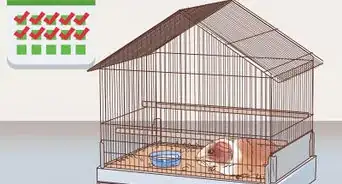This article was co-authored by Pippa Elliott, MRCVS. Dr. Elliott, BVMS, MRCVS is a veterinarian with over 30 years of experience in veterinary surgery and companion animal practice. She graduated from the University of Glasgow in 1987 with a degree in veterinary medicine and surgery. She has worked at the same animal clinic in her hometown for over 20 years.
There are 17 references cited in this article, which can be found at the bottom of the page.
This article has been viewed 33,308 times.
Seeing your female guinea pig with her babies (pups) can be heartwarming. As with any new mother, she will be very busy attending to her pups’ needs and finding time to take care of herself. In addition, the processes of giving birth and nursing can be very demanding on a female guinea’s body, and can lead to potential health complications in both the mother and her pups. As happy as you are with the sight of new little ones in your female guinea pig’s cage, you will need to be responsible for making sure both the mother and pups are comfortable, healthy, and well cared for.
Steps
Housing and Feeding the Mother Guinea Pig
-
1
-
2Feed the mother guinea pig a healthy diet. Your female guinea pig will need to eat a healthy diet to have enough energy and nutrients to meet the demands of pregnancy and nursing. Components of a healthy, balanced diet are fresh vegetables (e.g. turnip greens, cucumbers); small amounts of fresh fruits (e.g. kiwi, papaya, strawberries); and vitamin C-fortified guinea pig pellets.[3]
- Vitamin C is important to prevent a pregnancy complication called pregnancy toxemia.
Advertisement -
3Supplement the mother guinea pig’s diet with calcium. Your female guinea pig's calcium stores will drop significantly during pregnancy and nursing. Provide her with a supply of alfalfa hay,[4] which is an excellent source of calcium.[5] Alfalfa hay is high in calories and calcium. Supplement her her regular hay with alfalfa hay to give her an energy boost.
- Timothy hay is also a good choice for female guinea pigs, but is lower in calcium than alfalfa hay.[6]
- Alfalfa hay should not replace her regular food — it should be provided in a limited amount as a supplement.
Attending to the Mother Guinea Pig After Birth
-
1Replace the cage bedding regularly. Now that your female guinea pig has pups to care for, her cage will probably get messier than usual; however, she may be too exhausted to take care of all of her motherly duties after she has given birth. Initially, remove the contaminated bedding where the births took place.[7] Then, change out the bedding once a day.
- Wood shavings are a good bedding option, but you must make sure the shavings are free of aromatic oils — these oils can cause severe respiratory illness in guinea pigs. Also, the shavings should not be made of sawdust or cedar.
- HySorb wood shavings are one of the best types of wood shavings available, but they are expensive.
- Newspaper is a less expensive option, but is not absorbent and does not absorb odor. If you choose to use newspaper, you should use it in conjunction with a more absorbent bedding that is better at controlling odors.
- Other bedding options include cotton cloth, cotton fleece, and towels. Each option is very absorbent, but may need to changed and cleaned on a daily basis.[8]
-
2Give the mother guinea pig time to nurse her pups. Guinea pig pups are essentially born ready to go: their eyes are open, they have hair and a full set of teeth, and they can run around on their own.[9] They will still need to nurse, though, for three weeks before they are ready to be removed from their mother.
-
3Do not be concerned about the mother guinea pig’s maternal instincts. Other than nursing, a female guinea pig is usually not very ‘motherly’ toward her pups. Even before she gives birth, you will notice that she does not prepare a nesting area in the cage. After birth, do not be surprised if she doesn’t pay much attention to her pups.[12]
- Adult female guinea pigs are typically not very protective of their young.[13]
- Rather than stepping in to raise the pups on your own, allow the mother to nurse her pups, even if it seems like she doesn’t care for them very much.
Addressing Health Concerns
-
1Monitor the mother guinea pig for pregnancy complications. Since baby guinea pigs are born fully furred and ready to go, the mother guinea pig is at increased risk of experiencing health problems during and after pregnancy. For example, the mother guinea pig may experience a difficult birth and end up with a prolapsed uterus. You will see the uterus protruding out of her vaginal area.[14]
- She may also experience circulatory problems because of the extra weight she’s carrying before birth.[15] If her blood is not circulating properly, she may seem overly exhausted and thus unable to care for her pups.
- Take the mother guinea pig to your veterinarian right away if she is experiencing complications after birth. She may need intensive veterinary care.
-
2Check the mother guinea pig’s mammary glands. Mastitis (inflammation of the mammary glands) is common in guinea pigs and can occur after birth. If the mother guinea pig’s mammary glands feel hard or painful to the touch, or look bluish, she probably has mastitis.[16]
- Check the milk as well. Off-colored or clumped milk are often associated with mastitis.[17]
- Mastitis is a bacterial infection.[18] If left untreated, it can spread through the mother’s guinea pigs bloodstream. Take her to your veterinarian immediately for treatment (e.g. antibiotics, anti-inflammatory medications).[19]
-
3Keep the mother guinea pig away from male guinea pigs. Although your mother guinea pig may feel exhausted after giving birth, her body will already be ready to become pregnant again. If you have adult male guinea pigs, keep them away from her to prevent back-to-back pregnancies. [20]
Caring for the Mother Guinea Pig’s Pups
-
1Position a lower water bottle for the pups. Both the mother guinea pig and her pups will need to stay well hydrated. Since the pups are so small, you will need to give them their own water bottle that will be low enough for them to sip from easily.[23] The pups’ water bottle will probably be too low for their mother to sip from, so you should purchase another water bottle and position it at a higher height for her.
- You may have to go through a trial and error period to determine the ideal water bottle positions for the mother and her pups.
-
2Handle the pups. It is okay to start handling the pups soon after they are born — as long as you don’t interfere with the mother guinea pig’s motherly duties (e.g. licking the pups, eating the placenta, etc). Use two hands to handle the pups: one to support the front end, and one to support the back end. Hold the pup close to your chest and talk to it in a soothing voice.[24]
- The pups may be a bit squirmy the first time you pick them up. It isn’t used to being held, and may miss mommy. Gently lower the pup back into the cage when it starts to squirm.
- Early and frequent handling will help socialize the pups and get them comfortable with the human touch.
- Handle the pups only when they are awake and not nursing.
-
3Monitor the pups' weights. Record each pup's weight soon after they are born, and then daily for their few weeks of life. Healthy pups will gain weight steadily. If a pup is not gaining weight like the rest, it may not be nursing well. For this pup, you should try to give it extra private time with the mom so it can have a better chance to nurse.
- It is common for pups to lose a little weight in the first few days after birth, then start gaining weight.
-
4Watch the pups for signs of illness. This is particularly important for white guinea pigs, which are susceptible to a syndrome called Lethal White Syndrome. Signs of this syndrome include small or missing eyes, crooked teeth, and blindness and/or deafness. If you have white guinea pigs pups and notice any of these clinical signs, take them to your veterinarian for treatment.
- The fact that your guinea pig pups are white does not automatically mean they will develop the syndrome.
- In general, guinea pigs are hardy,[25] so the pups will probably be just fine after birth.
-
5Determine the sex of the pups. Although the pups are tiny, there is an easy way tell which ones are female and which ones are male. Check the anal area of each pup: female pups will have ‘Y’-shaped skin flaps on top of their anuses, and male pups will have slender openings instead of the flaps.[26]
- If you are uncomfortable with doing this, take the pups to your veterinarian for the sex determination.
-
6Keep the male and female pups in separate cages after nursing. Not only does the mother guinea pig need to be protected from the male pups, but the female pups need protection as well — the male pups could even try to impregnate their sisters! Male pups should be separated from the mother and female pups at three weeks of age (right after nursing). The female pups can stay with the mother until four weeks age, then be moved to their own cage.[27]
-
7Find a home for the pups. As much as you love the pups, it may not be feasible for you keep them all. It is ideal to adopt pups out in single-sex pairs. If you have an odd number of pups, then you can try to find someone who already owns a guinea pig that is the same sex as the ‘odd number’ pup you would like to give away.
- Although tempting, it is not a good idea to offer the pups as ‘free to a good home.’ This can actually devalue them, and cause them to be seen as unimportant and disposable to the prospective owner.
- Do not give the pups to a pet store. It is likely that the pet store does not screen potential buyers, so someone who does not know how to care for them, and may care for them improperly, could purchase the pups. In addition, the pups could be used as food for the reptiles.[28]
- If you are unable to rehome the pups on your own, consider contacting a reputable guinea pig rescue organization in your area. Your veterinarian or local pet store may be able to recommend who to contact.
Expert Q&A
-
QuestionWhat age can a female guinea pig get pregnant?
 Melissa Nelson, DVM, PhDDr. Nelson is a Veterinarian who specializes in Companion and Large Animal Medicine in Minnesota, where she has over 18 years of experience as a veterinarian in a rural clinic. She received her Doctor of Veterinary Medicine from the University of Minnesota in 1998.
Melissa Nelson, DVM, PhDDr. Nelson is a Veterinarian who specializes in Companion and Large Animal Medicine in Minnesota, where she has over 18 years of experience as a veterinarian in a rural clinic. She received her Doctor of Veterinary Medicine from the University of Minnesota in 1998.
Veterinarian Female guinea pigs can get pregnant when they are just 2 months old. This is interesting because guinea pig pregnancy lasts about 2 months.
Female guinea pigs can get pregnant when they are just 2 months old. This is interesting because guinea pig pregnancy lasts about 2 months. -
QuestionCan you cuddle with a guinea pig?
 Melissa Nelson, DVM, PhDDr. Nelson is a Veterinarian who specializes in Companion and Large Animal Medicine in Minnesota, where she has over 18 years of experience as a veterinarian in a rural clinic. She received her Doctor of Veterinary Medicine from the University of Minnesota in 1998.
Melissa Nelson, DVM, PhDDr. Nelson is a Veterinarian who specializes in Companion and Large Animal Medicine in Minnesota, where she has over 18 years of experience as a veterinarian in a rural clinic. She received her Doctor of Veterinary Medicine from the University of Minnesota in 1998.
Veterinarian Yes, you can cuddle with a guinea pig, but only on their terms. It's important to accommodate their fears and quirks.
Yes, you can cuddle with a guinea pig, but only on their terms. It's important to accommodate their fears and quirks. -
QuestionCan I touch a newborn guinea pig?
 Melissa Nelson, DVM, PhDDr. Nelson is a Veterinarian who specializes in Companion and Large Animal Medicine in Minnesota, where she has over 18 years of experience as a veterinarian in a rural clinic. She received her Doctor of Veterinary Medicine from the University of Minnesota in 1998.
Melissa Nelson, DVM, PhDDr. Nelson is a Veterinarian who specializes in Companion and Large Animal Medicine in Minnesota, where she has over 18 years of experience as a veterinarian in a rural clinic. She received her Doctor of Veterinary Medicine from the University of Minnesota in 1998.
Veterinarian You should only be touching a newborn guinea pig if it is to check on their health. Otherwise, leave them alone.
You should only be touching a newborn guinea pig if it is to check on their health. Otherwise, leave them alone.
Warnings
- Female guinea pigs can develop ovarian cysts. Consider spaying your female guinea pig after she has given birth to reduce the likelihood of her developing these cysts.⧼thumbs_response⧽
- Female guinea pigs have a 20% chance to dying due to pregnancy complications.[31] It is best that you not allow your female guinea pig to become pregnant at all.⧼thumbs_response⧽
- Male pups can impregnate their mothers. Place the male pups in a separate cage as soon as the nursing period is over.[32]⧼thumbs_response⧽
References
- ↑ http://www.humanesociety.org/animals/guinea_pigs/tips/guinea_pig_housing.html?credit=web_id81806465
- ↑ http://www.guineapigmanual.com/guinea-pig-handling/
- ↑ http://www.humanesociety.org/animals/guinea_pigs/tips/guinea_pig_food_choices.html
- ↑ http://animals.mom.me/much-alfalfa-hay-should-feed-guinea-pig-11533.html
- ↑ http://www.drsfostersmith.com/pic/article.cfm?aid=1302
- ↑ http://www.drsfostersmith.com/pic/article.cfm?aid=1302
- ↑ http://animals.mom.me/after-guinea-pig-delivery-9677.html
- ↑ http://www.guineapigmanual.com/guinea-pig-bedding/
- ↑ https://petguineapigcare.com/breeding-babies/
- ↑ http://www.smallanimalchannel.com/critter-experts/guinea-pig/handling-rules-for-newborn-guinea-pigs-1108.aspx
- ↑ http://www.smallanimalchannel.com/critter-experts/guinea-pig/handling-rules-for-newborn-guinea-pigs-1108.aspx
- ↑ https://petguineapigcare.com/breeding-babies/
- ↑ https://petguineapigcare.com/breeding-babies/
- ↑ http://www.guinealynx.info/breeding.html
- ↑ http://www.guinealynx.info/breeding.html
- ↑ http://www.2ndchance.info/gpreprodprobs.htm
- ↑ http://www.2ndchance.info/gpreprodprobs.htm
- ↑ http://www.2ndchance.info/gpreprodprobs.htm
- ↑ http://www.petmd.com/exotic/conditions/endocrine/c_ex_gp_mastitis?page=2
- ↑ http://kb.rspca.org.au/i-think-my-guinea-pig-might-be-pregnant-what-should-i-do_354.html
- ↑ http://kb.rspca.org.au/i-think-my-guinea-pig-might-be-pregnant-what-should-i-do_354.html
- ↑ http://animals.mom.me/old-guinea-pig-leave-its-mom-10322.html
- ↑ http://animals.mom.me/handraise-baby-guinea-pigs-6520.html
- ↑ http://www.guineapigmanual.com/guinea-pig-handling/
- ↑ http://www.vcahospitals.com/main/pet-health-information/article/animal-health/guinea-pigs-problems/1070
- ↑ http://animals.mom.me/old-guinea-pig-leave-its-mom-10322.html
- ↑ http://www.smallanimalchannel.com/critter-experts/guinea-pig/handling-rules-for-newborn-guinea-pigs-1108.aspx
- ↑ http://www.cavyspirit.com/breeding.htm#jacba
- ↑ http://www.smallanimalchannel.com/critter-experts/guinea-pig/handling-rules-for-newborn-guinea-pigs-1108.aspx
- ↑ http://www.smallanimalchannel.com/critter-experts/guinea-pig/handling-rules-for-newborn-guinea-pigs-1108.aspx
- ↑ http://www.guinealynx.info/breeding.html
- ↑ http://animals.mom.me/old-guinea-pig-leave-its-mom-10322.html
About This Article
To take care of a pregnant female guinea pig, feed it a healthy, balanced diet of fresh vegetables, fresh fruits, and vitamin C-fortified guinea pig pellets. You should also ensure it’s getting enough calcium by supplementing its regular hay with a limited amount of alfalfa hay. Once the babies are born, replace the cage bedding once a day, and make sure not to use shavings with aromatic oils or ones that are made of sawdust or cedar since these can cause health issues. For more information from our Veterinary co-author, including how to care for the newly born guinea pig pups, scroll down!
